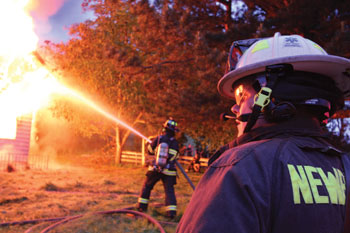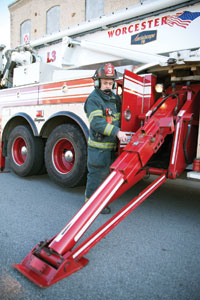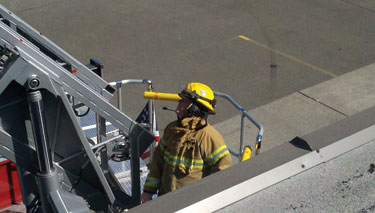Alan M. Petrillo
Firefighters have enjoyed wireless connectivity through their desktop computers, laptops, smart phones, and notepads for a while. Now they are using that same type of connectivity on fire scenes through increased use of wireless headsets.
That wireless connectivity is being applied in a number of situations, from ground to aerial tip, between pump operator and officer, among all crew members on an apparatus, and between an officer and individual firefighters.
Cord-Free
Jim Roberts, president of Setcom Corp., says his company has been in the communications business for 42 years and has been making apparatus intercom systems since the early 1990s. Setcom introduced its first wireless product for the fire service in the fall of 2009-the Liberator-which Roberts says was a response to many customers asking to be free of corded headsets. “At that time, the wireless headset was chiefly used by the apparatus operator, where he could get out of the vehicle and operate the pump without having to unplug and plug his headset,” Roberts says. “He also was able to move around the vehicle untethered.”
The wireless headset concept caught on with firefighters, Roberts points out, and many departments now outfit officers, aerial operators, and other fire crew members with wireless headsets. “Setcom has added some features to our wireless headsets that aren’t seen elsewhere,” Roberts adds, “like an advanced motion sensor inside the headset that detects motion along three-dimensional axes where the headset turns on instantly when it is put on the head. The headset will go to sleep in 15 minutes if there is no motion.”
 |
| (1) Firecom’s wireless headsets are often used in command situations to allow the fireground commander more latitude in moving outside of the command post area. (Photo courtesy of Firecom.) |
Roberts notes that the Liberator has an internal lithium ion battery in the headset’s left cup that provides 30 hours of life and has a duty cycle of three to five years, depending on how it is used.
Using fire department feedback, Setcom learned that chiefs and firefighters wanted to interface the wireless headset with the apparatus intercom and radio but also with portable radios and cell phones, Roberts says. “We developed the Liberator so it can communicate over the vehicle’s mobile radio and intercom through Bluetooth® technology to a cell phone and through a connection wire from a portable radio to the left cup of the headset,” Roberts points out. “The user is able to set the volume separately for each of the radio or intercom functions. In the primary headset mode, you can hear all the radio and intercom connections simultaneously, and by hitting a button on the headset’s right cup, the firefighter can communicate over a cell phone.”
Communicating over the cell phone link disconnects the headset from the mobile radio and intercom but keeps it connected to the portable radio, he adds.
In late summer, Setcom introduced its Liberator TwinTalk system that doesn’t require a base station. Roberts says TwinTalk has a line-of-sight range of up to 1,200 feet, uses the Liberator instant-on feature, has Bluetooth cell phone integration, and is especially useful in high-noise situations, aerial operations, and wildland firefighting where two-person teams need to be in constant communication.
Reliable Wireless
Tim O’Brien, director of sales for Firecom, says his company introduced its UHW-10 wireless headset four and a half years ago, but that unit has been improved to the UH-51, 52, and 54 wireless series released in the Fall of 2011.
O’Brien says Firecom’s first product used Bluetooth 2.4 technology that didn’t work very well around metal objects but that its current wireless headsets use a FCC-licensed protected spectrum frequency developed for reliable wireless communications use in large buildings. “This system works well around metal,” he says.
Firecom’s wireless headsets interface with a vehicle’s mobile radio and intercom and connect to a portable radio through a wired connection. “We offer over-the-helmet and under-the-helmet headsets,” O’Brien says, “and are the first and only to offer a system without a belt pack or external antenna. The system is built into the headset itself.”
Firecom’s latest wireless headset systems have a programmable noise gate, O’Brien points out, a 24-hour lithium polymer hybrid battery that can be fully charged in two hours, have been tested to military specification (MilSpec) IP65 to perform in heat and cold, and are implanted with a smart charger that can handle both low- and high-power charging at varying amperages. “We’re seeing firefighters using wireless headsets when backing trucks into firehouse bays,” O’Brien says, “which is not a use that we had considered when we were in development. The headsets also are useful in providing more efficiency on aerials, allowing personnel to move around the fireground instead of monitoring a radio in a truck, allowing communication with extrication personnel on a scene away from the vehicle, and in marine firefighting situations where the biggest challenge is cord entanglement.”
O’Brien adds that Firecom has been seeing wireless headset use more in command situations, where the fireground commander can move around and not be tethered to a command post.
 |
| (2) An aerial ladder operator for the Worcester (MA) Fire Department checks the positioning of a ladder jack while communicating with his officer through a David Clark Co. wireless headset. (Photo courtesy of David Clark Co. Inc.) |
Room for Wired and Wireless
Bob Daigle, product manager of David Clark Co. Inc., says his firm has been making wired headsets since the early 1980s and launched its wireless headset product, the 9900 series, in April 2011. “The most common situation for use of wireless headsets is between a driver and an officer,” Daigle points out, “because a lot of departments like to keep the jump seats wired instead of wireless.”
David Clark’s wireless system works through a gateway or base station in the apparatus that can accommodate up to four wireless headsets. Its belt unit has electronics that have been subjected to military drop tests and marine integrity testing for durability, O’Brien notes, “so there are no bulky areas in the headsets.”
O’Brien says David Clark offers seven wireless headset options-dual over-the-ear, dual behind-the-ear, single-ear over-the-head, single-ear behind-the-head, a microphone shield version (instead of a boom microphone), a slim version to fit under ballistic military helmets, and an ultra-light version. “All of these headsets, with the exception of the ultra-light, are for use in high-noise environments and encompass noise reduction,” O’Brien says.
 |
| (3) Central Pierce (WA) Fire & Rescue uses Setcom wireless headsets for its fire crews-from pump operators and officers to aerial operators and truck personnel. (Photo courtesy of Setcom.) |
Migration to Wireless
Tim Theis, general manager of Sigtronics Corp., says his company is still developing its wireless headset and currently is performing field tests to determine what users think about the product. “We’re tweaking some things in the headset, and once we’re satisfied, we will go into full-bore production and get it out the door,” Theis says.
Theis points out that he expects the Sigtronics unit to have an automatic shutoff capability if the unit is not worn for a certain length of time, have a 300-foot range around the base station on the apparatus, employ a push-to-talk button for transmitting on radio, and be compatible with all Sigtronics intercoms.
He says Sigtronics has targeted the end of 2012 as a potential release date for the product, but that date depends on what the field trials turn up and if any more modifications to the unit are necessary.
O’Brien says more and more fire departments are moving toward wireless headsets for a number of reasons. “They are an improvement over what fire departments have been using,” he says, “and with their noise-attenuating qualities, fire departments are considering them a necessity instead of a luxury, especially considering the hearing protection they afford. They also see wireless as an enhancement of the freedom of mobility that communications need to have instead of being tethered to an apparatus.”
ALAN M. PETRILLO is a Tucson, Arizona-based freelance writer and is a member of the Fire Apparatus & Emergency Equipment editorial advisory board. He served 22 years with the Verdoy (NY) Fire Department, including in the position of chief.

